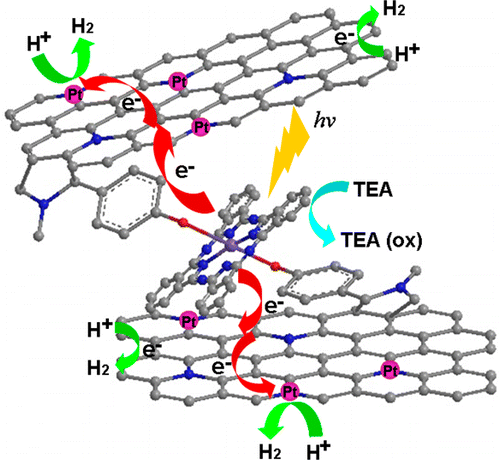Ping Yang*†(杨平)
† College of Chemistry, Chemical Engineering and Materials Science, Soochow University, Suzhou, 215123, China
‡ Key Laboratory of Nano-Bio Interface, Division of Nanobiomedicine, Suzhou Institute of Nano-Tech and Nano-Bionics, Chinese Academy of Sciences, Suzhou 215123, China
ACS Appl. Mater. Interfaces 2015, 7, 3732–3741
To improve the photocatalytic activity of graphene-based catalysts, silicon phthalocyanine (SiPc) covalently functionalized N-doped ultrasmall reduced graphene oxide (N-usRGO) has been synthesized through 1,3-dipolar cycloaddition of azomethine ylides. The obtained product (N-usRGO/SiPc) was characterized by transmission electron microscopy, atomic force microscopy, Fourier transform infrared spectroscopy, Raman spectra, X-ray photoelectron spectroscopy, fluorescence, and UV–vis spectroscopy. The results demonstrate that SiPc has been successfully grafted on the surface of N-usRGO. The N-usRGO/SiPc nanocomposite exhibits high light-harvesting efficiency covering a range of wavelengths from the ultraviolet to visible light. The efficient fluorescence quenching and the enhanced photocurrent response confirm that the photoinduced electron transfers from the SiPc moiety to the N-usRGO sheet. Moreover, we chose Pt nanoparticles as cocatalyst to load on N-usRGO/SiPc sheets to obtain the optimal H2 production effect. The platinized N-usRGO/SiPc (N-usRGO/SiPc/Pt) demonstrates good hydrogen evolution performance under both UV–vis and visible light (λ>400 nm) irradiation. The apparent quantum yields are 1.3% and 0.56% at 365 and 420 nm, respectively. These results reveal that N-usRGO/SiPc/Pt nanocomposite, consolidating the advantages of SiPc, N-usRGO, and Pt NPs, can be a potential candidate for hydrogen evolution from water under UV–vis or visible light irradiation.

链接:
//pubs.acs.org/doi/abs/10.1021/am508476d?journalCode=aamick